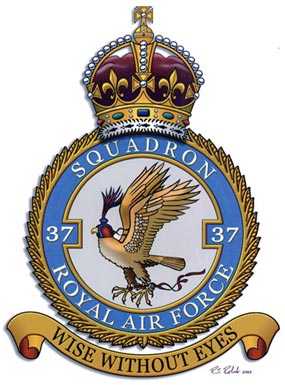GROUNDCREW - THE "ERKS"
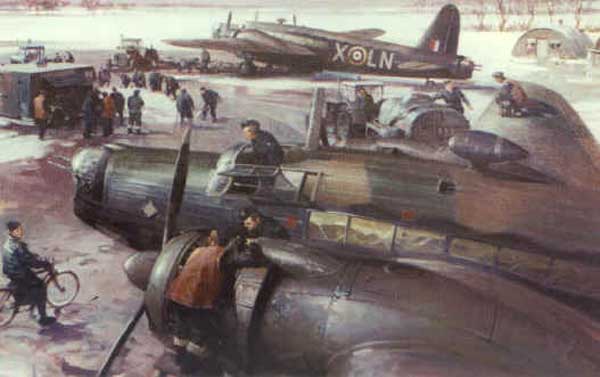
Typical conditions for Wellington ground crew
"down the flights" - from a painting by Michael Turner.
No examination of squadron operations can be very complete without a look at the usually overlooked groundcrew, or "Erks".
On a mobile Wellington squadron in the Middle East or the Mediterranean, the "Erks" were the key to the ability of the squadron to conduct operations. Not only did they do their work well, but they did it under terrible conditions. Former aircrew always have incredibly high praise for these men.
Ground Crew Organization
Every squadron had a very large ground staff to keep it running. The chief administrative officer of the squadron was the Adjutant, usually at least a Flying Officer or above in rank. Often a veteran of WWI or an officer too old for flying duties (although squadron records show that "the adj" often got air time just to "get some in"), the Adjutant answered directly to the Commanding Officer of the Squadron.
Under the Adjutant's command were the Supplies Officer, Intelligence Officer, Catering Officer, Medical Officer, Signals Officer, Armaments Officer and Engineering Officer. Under each of these would be a complete unit responsible for a specific facet of the squadron's life. The men in these units would be NCO's - Sergeants and Flight Sergeants - and "Rankers" - Corporals, Leading Aircraftsmen , and Aircraftsmen 1 and 2 (AC1 and AC2). The Catering Officer would have a number of cooks under his command, the medical officer would have orderlies and other assistants, and so on. In addition to these each squadron had, from its flying component, an operational leader in each of the aircrew "trades", who held responsibilities in addition to regular flying duties. These positions were Gunnery Leader, Bombing Leader, Navigation Leader, and Signals Leader.
The Engineering Officer was responsible for the maintenance of all aircraft and aircraft systems and it was his duty to ensure these were always in a state of high readiness for operations. On a mobile squadron like 37, related equipment such as starters, batteries, motor transport, gasoline tankers, bomb tractors, etc. all came under his command as well. It was his responsibility to see that the maximum number of aircraft from the squadron were serviceable and ready for ops at any given time. Serviceability levels were a matter of pride to Engineering Officers as well as being of great importance to the effectiveness of the squadron as an offensive force. This job was made even more difficult in a theatre of war where the supply lines ran all the way back to the UK or North America, where spares were scarce and working conditions terrible. In addition, unlike aircrew, who passed through the squadron after completing their tour of operations, ground crew stayed with the squadron "at the King's pleasure" - until posted to another base or duty. Many of the ground staff on 37 Squadron at Tortorella in 1944 had arrived in North Africa on a "three month posting" in 1942. That their morale and pride in their work remained so high was a compliment to their training and character.
The RAF prided itself on having the best trained ground crews in the world. The "Halton Apprenticeship Programme" started by Air Vice Marshall "Boom" Trenchard, saw "boy apprentices" enter the program at age 15 and undergo a rigorous education of three years before starting their service with the RAF at age 18. The demands of the war eased this standard somewhat and many technical trades from "civvy street" were trained by the Regular Force as ground crew in the RAFVR.
The basis for a ground crew was the Flight. Within a Flight of aircraft (which could range from 6-9 aircraft) ground crew would be designated to service certain aircraft. Ideally one aircrew would have one aircraft, but often this was not possible and the crews would have more than one aircraft to look after. These men took great pride in their aircraft. In fact, it was often felt, and very often said, that the ground crews "owned" the aircraft and "lent" them to aircrew provided that they bring them back in one piece.
The unofficial motto of these ground crews was "Ubendum Wemendum".
An Erk's Day
On a typical day when "ops were on" for that night, the preparations would begin early in the morning with the Daily Inspection (DI). The crew that had last flown the aircraft on ops would come "down the flights" to discuss any equipment or performance problems encountered on the aircraft with the ground crew. These would be duly noted on the "snag sheet" (Form 700).
As long as the ground crew had Form 700 the aircraft belonged to them and was their responsibility. Only the ground crew could certify an aircraft as serviceable for ops and no one of any rank could order an erk to sign off the Form 700. Only when all "snags" had been checked off and the captain of the aircraft had signed off the form did the responsibility for the airplane go to the pilot.
Daily Inspections included a check of all engine controls and parts, all hydraulics and pneumatics, all electrical systems, radios, navigation aids, lights, brakes etc. It also included the repair of minor battle damage and attention to anything reported by the aircrew on the "snag list". Ground running of engines to check for "mag drop", fuel leaks, oil burning, sticking sleeve valves, etc. were also part of the Daily Inspection. In addition to the DI’s, the Engineering Officer had to schedule aircraft for major inspections and overhauls in such a way as to have some aircraft serviceable at all times.
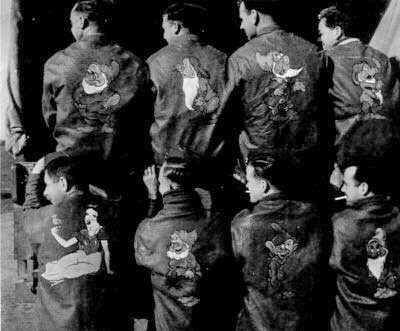
205 Group ground crew wearing USAAF flight jackets with Snow White and the seven Dwarves on their backs. |
Erks came in many forms. "Fitters" were generally responsible for the engines and other mechanical parts of the aircraft. "Riggers" were responsible for the airframe and the related components including fueling. The term rigger came from the days of the old wire-braced aircraft where there was literally rigging in the form of wires and turnbuckles to be attended to. "Armourers" were responsible for all arming of the aircraft including bombs and defensive guns.
Preparations for operations continued with the completion of an NFT or Night Flying Test by the crew who were to fly the aircraft on ops that night. NFT’s were flown during the day and usually lasted about 30 minutes, during which the aircrew would check the operation of all systems and report any further snags or glitches. After the NFT, the ground crew would repair any new problems reported, then begin to prepare the aircraft for that nights "ops".
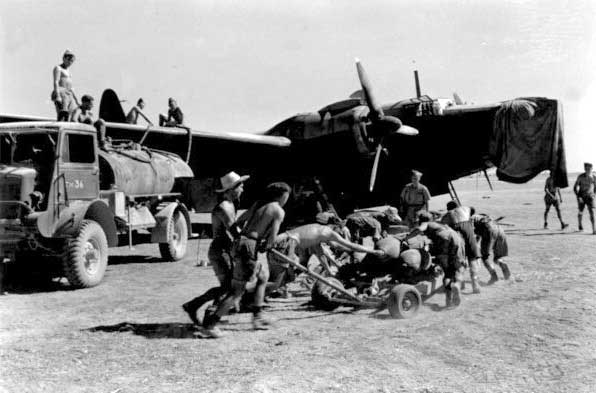
205 Group erks preparing a Wellington for ops
Operational preparation consisted on filling the aircraft tanks with sufficient 100 Octane Avgas for the distance to the target. Preparing a Wellington for an operation was always a balancing act between fuel weight, bomb load weight and distance to target. In other words, to fly farther required more fuel which represented more weight, and since the total "all up" weight of the aircraft could not be exceeded, that meant a smaller load of bombs could be carried. The fuel system in the Wellington was complicated compared to other aircraft. There were two main wing tanks, two 55 gallon engine nacelle tanks as well as overload tanks which could be carried in the bomb bay cells and a smaller one on the rest cot in the fuselage. The changeover between all of these tanks was a confusing set of valves and taps. In addition oil had to be added to the Bristol Hercules engines as well as to a tank in the fuselage. During flight oil had to be pumped at regular intervals to the engines using a manual "wobble pump". Hydraulic fluid was also essential for the operation of the gun turrets and undercarriage as well as compressed air to run the flaps and the brakes. Oxygen systems had to be checked and filled and intercom systems had to be fully functional. A duff intercom was reason to "boomerang" a sortie since the crew had to be able to communicate with each other in order to function.
The type of warload to be carried was specified in the operational orders that came down to the squadron from Group HQ. Bombs and flares had to be transported to the aircraft pans from the bomb dump where they were stored. At the dump fuses and detonators were installed and safety wires attached. The bomb was fused by the rotation of a small propeller on the nose or tail which, when it was turned by the airstream after dropping, would twist a forked rod inside the bomb and set the detonator to "active". A time delay was built into high explosive bombs ranging from a standard .025 seconds (to give the bomb a chance to penetrate a building before exploding) to several hours or days to cause disruptions on airfield targets. Bombs were winched into the bomb bay cells on carriers using a winch system that was built into the aircraft. A crank handle would be placed into holes corresponding to different locations in the bomb bay and the bombs manually winched up. Balancing the different types of bombs was essential for the flying characteristics of the aircraft. Each aircraft on the squadron might have a different bomb load for an op. Illuminators would be loaded with 54 magnesium parachute flares- in bundles of three on the 18 bomb carrier stations. Other aircraft would have a mix of high explosive bombs (250 lb. G.P., 500 lb. M.C., and 4000 lb. H.C.); some would have a load of SBC's full of 4 lb. incendiaries. Naval mines required the assistance of special armourers from the Royal Navy. Each bomb had to have its fuse set for the required timing, detonators inserted, the safety wire attached to the carrier, the tail fins installed and inspected for dents and the shackles on the carriers checked for a firm grip. The settings and placements of the bomb load would then have to be given to the air bomber of the flight crew so that he could set up his bombing panel.
Often there were also nickels to load onto the aircraft - usually in the fuselage where they would be manually tossed down the flare chute, but sometimes in the bomb bay where they would be dropped with the bombs.

Armourers belting up ammunition
Also, the armourers had to check the belts of .303 ammunition for the guns. While the belts came assembled from the supply area, good armourers always ran them through a belt positioning machine to try and ensure that there would be no jams or stoppages when the gunner needed to use his weapons. Ammunition tracks inside the aircraft were also checked for dents and kinks that would cause gun problems. All guns were cleaned, oiled and field stripped between operations.
There were also many small jobs done by the ground crew did which, while they seem unimportant, were critical. All perspex surfaces were polished carefully. A speck of dirt on a turret could easily be mistaken for an attacking night-fighter. Anti-icing fluid for the windshield was an absolute necessity and the fluid tank had to be topped off and the pump checked. All lights had to be checked for proper operation as well as checking the dinghy, flare pistol and other emergency equipment that could mean life or death for the aircrew. Tire wear was a constant problem on the rough runways of Italy and tires had to be carefully inspected. A blown tire on takeoff with a full fuel and bomb load was usually fatal. Wellington tires were in such short supply on 37 Squadron that ops were almost bought to a stop at one point in 1944.
All of this work took place outside - there were no hangars. In the blazing heat of the desert riggers had to wear asbestos gloves to work on metal parts. In the cold rain and mud of an Italian winter fitters had to take off their gloves to reach various components, often suffering frostbite as a result. Armourers usually had to crouch in the mud and muck of the perimeter track to winch the bomb load aboard. It was also a race to get the aircraft ready for takeoff on time. Meals were often taken "on the hop" in order to ensure that aircraft were ready.
As the aircrew took over the aircraft there were often last minute problems to be overcome. Aircrew were given special instructions regarding the status of the aircraft and wished "good luck". Engine start was supervised by the ground crew chief along with the pilot. An erk was required to operate a priming tap in the wheel well and to connect and disconnect a starting battery in order to start the engines. The final ground crew job was to pull away the chocks from the wheels so that the aircraft could taxi away.
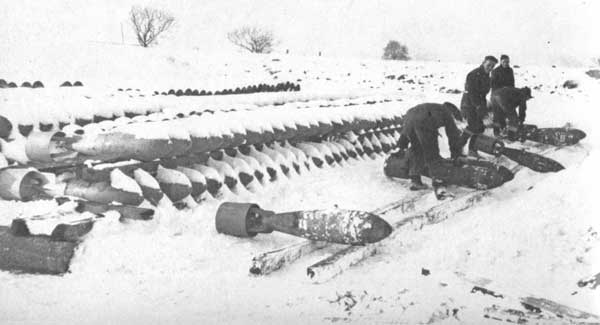
Erks in the snow rolling out 250 pound bombs for
loading on to the bombers.
At the end of this long day tired erks went for their meal of fried "bully beef" and tea, then retired to their shack-like tents which were heated by the very engine oil that they had drained from the aircraft engines. A few hours of sleep on a makeshift bed and the routine started all over again. The job was dirty, tiring, required great attention to detail and was extremely dangerous. Many erks gave their lives so that the squadron could continue to play an important role in winning the war. Armourers working with high explosives, tricky fuses, detonators, unexploded time-delay bombs and flares were all too often killed by their work. Fitters and riggers could be injured or killed by idling propellers or falls from wet and slippery aircraft. In the desert and early in the Italian campaign there was always the threat of enemy attack on the airfield. Constant movement caused many casualties. Crashes flying between airfields were all too common. Others were killed when Motor Transport slipped off roads in the icy Italian winter. All trades were subject to the malaria, dysentery and other diseases of the area and many died from their long exposure to this threat, weakened by substandard rations and poor housing.
Many crews recount the times when all other aircraft had returned and were standing on their pans, and there were one or two empty hardstandings filled only by the erks, patiently waiting, and praying, that their aircraft would return home.
One of the best tributes to the erks of 205 Group was written by Squadron Leader M. Foulis, D.F.C., who wrote:
"Our last job, early in 1945, was re-equipping the Wimpy squadrons then based in Italy with Liberators. It became quite common to try out two or even three Liberators at Maison Blanche before finding a serviceable kite; yet on landing at Foggia we were presented with fly-back Wellingtons which literally went like sewing machines - a tribute to the high quality of maintenance on the squadrons"
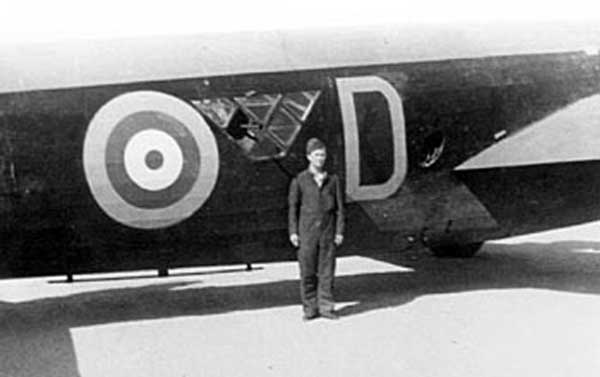 Eric Rowston, ground crew member of 37 Squadron, stands in front of Wellington LN798 "D" in Egypt, 1943. This is the same Wellington later flown by James MacIsaac in Italy. |
<< PREVIOUS |
NEXT >>
Home | Table of Contents

